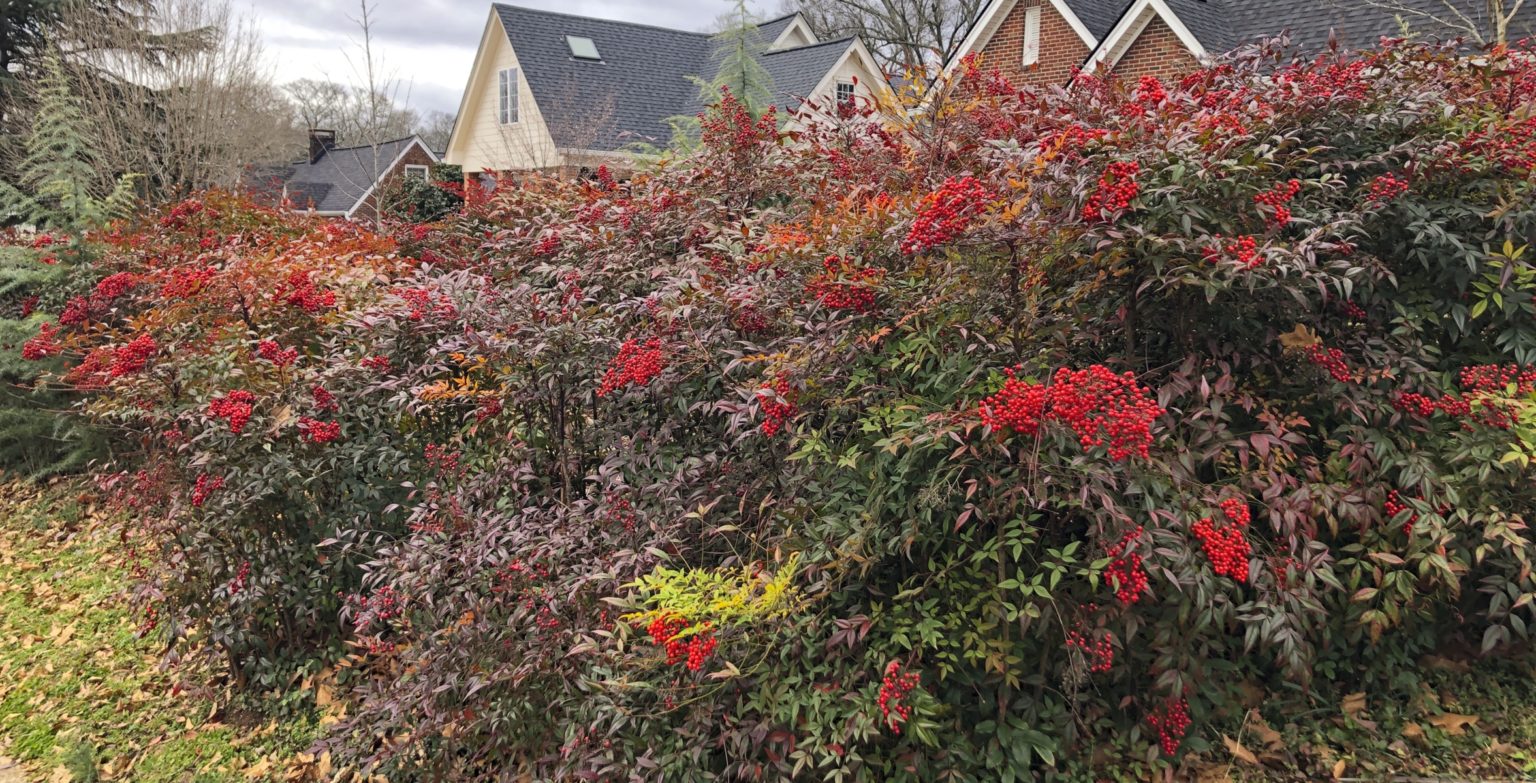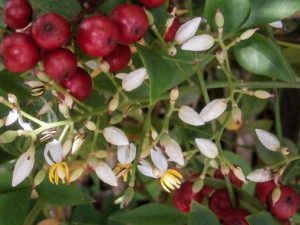An essay by Doug Lockard
An Old Story:
The Nandina story is one that epitomizes a significant challenge for our landscapes as well as our ecosystems today; exotic plants in the landscape. Exotics innocently introduced are often determined to be harmful to our wildlife and threaten our native species. This lovely Asian plant is a small semi-evergreen shrub introduced in the U.S. the early 1800’s. A plant that offers fall and winter interest to the garden with its bright red berries and burgundy leaves, in the spring with pleasant white flowers and in summer with dark evergreen foliage.
The Nandina is a hardy and fast-growing plant from sunny roadsides to undergrowth and in heavy shade in a variety moist soils, and birds can be seen eating the berries in fall and winter. It seems the perfect plant and it’s not difficult to understand why it has become a favorite of homeowners and is a staple of commercial nurseries. And therein lies the problem.
Ironically, the very things that make the Nandina so popular are the reason they are considered a ‘significant threat’ in our state by the SC Exotic Pest Plant Council (SC-EPPC), who refer to them as an “invasive exotic species which are established in natural areas, independently spreading, and causing significant damage to natural communities.”
So, what’s the problem?
Well, for starters, those lovely red berries are poisonous. When dozens of cedar waxwings were found dead in Thomas County, Georgia, researchers at the College of Veterinary Medicine, University of Georgia, found the cause to be Nandina berries…
“All the birds had intact Nandina berries in their crops. There was hemorrhaging in the heart, lungs, trachea, abdominal cavity and other organs. Nandina berries contain cyanide and other alkaloids that produce highly toxic hydrogen cyanide (HCN) which is extremely poisonous to all animals…”
Fortunately, birds such as the cedar waxwing, northern mockingbird and American robin, will normally consume the berries only when other food sources are not available. Other animals are also affected by the berries, including dogs.
The other problem with invasive species such as the Nandina is that they are much more aggressive than natives and displace those plants which are part of the food chain for natives here that evolved along-side them.
The U.S. Department of Agriculture states that the Nandina has naturalized and invaded our national parks, national wildlife refuges, national forests, city parks, and other habitats. The plant is aggressive, hardy, and grows in a wide range of conditions here in the Southeast. Their seeds are lightweight and in addition to be spread by wildlife, they carry easily in wind and water.
What Can We Do?
All of this paints a rather grim picture for a plant many of us in the Upstate may have in our yards. So, what can we do?
The SC-EPPC recommends removing the plant at a time when the seeds are not present (to prevent accidental spread), burning the removal, and if you cut rather than dig it up, then to also ‘paint’ the stumps with a glyphosate-based herbicide such as Round-up.
If you’re a devoted Nandina lover, and just can’t part with it, there are some sterile cultivars you can turn to as possible replacements that are less aggressive and lack the toxic seeds. You can also cut the berries from the plant early in the fall when they first appear and burn them.
The SC Native Plant Society suggests simply replacing them with any of a number of native species of similar characteristics that grow well in similar conditions and which contribute to the local food chain, including:
- Red buckeye (Aesculus pavia) – favorite of Ruby Throated Hummingbird
- Beautyberry (Calicarpa Americana) – Host for Rustic Sphinx Moth
- Witch hazel (Hamamelis virginiana) – Moth pollinator, Host for 58 species
- Oakleaf hydrangea (Hydrangea quercifolia) – Seeds feed birds & mammals
- Possumhaw (Ilex decidua) – Feeds birds and brilliant fall color
- Spicebush (Lindera benzoin) – Good fall color, feeds birds and butterflies
References:
For further reading on this subject, we refer you to the following:
- SC-EPPC Website: https://www.se-eppc.org/southcarolina/
- Brochure: https://www.se-eppc.org/southcarolina/scinvasives.pdf
- Brochure: https://www.se-eppc.org/southcarolina/Publications/InvasivePlantsBooklet.pdf
- Clemson: https://hgic.clemson.edu/factsheet/nandina/
- Audubon: https://ar.audubon.org/news/nandina-berries-kill-birds





